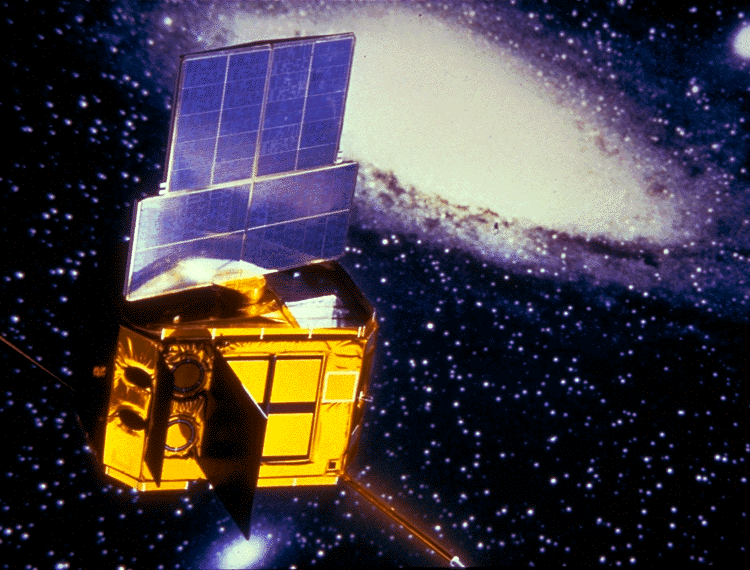EXOSAT Home Page - EXOSAT
EXOSAT
The European X-ray Observatory Satellite
| An artist's impression of the EXOSAT spacecraft |  |
EXOSAT (The European X-ray Observatory SATellite) was operational between 26 May 1983 and 9 April 1986 and made 1780 observations of most classes of astronomical object. EXOSAT was launched by a Thor-Delta rocket from Vandenburg AFB into a 90 hour highly-eccentric Earth orbit with an initial apogee of 191,000 km and an inclination of 73o. The payload consisted of three instruments that produced spectra, images and light curves in various EUV and X-ray energy bands:
- Two Low-Energy Imaging Telescopes (LE), each with a Channel Multiplie Array (CMA) detector array at the focus, were sensitive over the energy range 0.05-2 keV and used passband filters to obtain coarse spectral information. The insertion of a diffraction grating into the beam gave high-resolution Transmission Grating Spectra (TGS) capable of resolving emission-line complexes. These telescopes provided the first detailed observations in the Extreme Ultra Violet between 100 and 300 Å.
- The Medium-Energy (ME) instrument consisted of an array of proportional counters with a total area of 1600 cm² that gave moderate spectral resolution in the 1-50 keV energy range.
- A factor of two better spectral resolution over the 2-20 keV energy range was provided by the Gas-Scintillation Proportional Counter (GSPC) with a smaller collecting area of 100 cm².
The original objective of the mission was to use lunar occultation to obtain precise positional information for the relatively small number of X-ray sources that were then known. The science instruments were operated above 50,000 km and this allowed uniterrupted scientific operations for around 76 hours of every 90 hour revolution. EXOSAT was visible from the ground station near Madrid for practically the entire time that the instruments were observing and there was therefore no need for any on-board storage. The telemetry rate was 8 kbps and an on-board computer (OBC), programmable from the ground, preprocessed and compressed the data. The flexibility of the OBC significantly enhanced the quality of the data. The scientific operations were conducted from ESOC, in Darmstadt. One of the most important EXOSAT discoveries was finding quasi periodic oscillations in the X-ray intensity of a number of low-mass X-ray binaries.
The original data was stored on 1600 bpi 12" magnetic tapes (called Final Observation Tapes, or FOTs). These have been copied to more modern media and are available for download from the FOT list. the EXOSAT Interactive Analysis, software to read them and perform a scientific analysis is provided for a number of computer platforms.
As well as pointed observations, the ME detectors were normally left operating as EXOSAT manoeuvred between targets. This has provided a rich large-area X-ray sky survey, called the Medium Energy Slew Survey.
Here is the list of refereed EXOSAT Publications (link to ADS Private Library)
ESA's EXOSAT Science Archive. Images, spectra and light curves are available now through this new tool which makes use of ESA's new archive technology. This archive will allow astronomers to complement modern X-ray studies with historical measurements.
ESA Contact: A. Parmar
